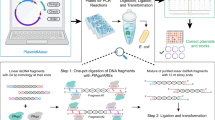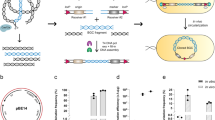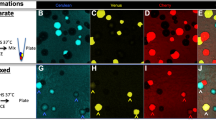Abstract
We developed a generic method for high-throughput cloning in bacteria that are less amenable to conventional DNA manipulations. The method involves ligation-independent cloning in an intermediary Escherichia coli vector, which is rapidly converted via vector-backbone exchange (VBEx) into an organism-specific plasmid ready for high-efficiency transformation. We demonstrated VBEx proof of principle for Lactococcus lactis, but the method can be adapted to all organisms for which plasmids are available.
This is a preview of subscription content, access via your institution
Access options
Subscribe to this journal
Receive 12 print issues and online access
$259.00 per year
only $21.58 per issue
Buy this article
- Purchase on Springer Link
- Instant access to full article PDF
Prices may be subject to local taxes which are calculated during checkout


Similar content being viewed by others
References
Grisshammer, R. & Tate, C.G. Q. Rev. Biophys. 28, 315–422 (1995).
Tate, C.G. et al. Biochim. Biophys. Acta 1610, 141–153 (2003).
Ding, H.T. et al. Acta Crystallogr. D Biol. Crystallogr. 58, 2102–2108 (2002).
Lundstrom, K. et al. J. Struct. Funct. Genomics 7, 77–91 (2006).
Kunji, E.R., Slotboom, D.J. & Poolman, B. Biochim. Biophys. Acta 1610, 97–108 (2003).
Quick, M. & Javitch, J.A. Proc. Natl. Acad. Sci. USA 104, 3603–3608 (2007).
Aslanidis, C. & de Jong, P.J. Nucleic Acids Res. 18, 6069–6074 (1990).
Walhout, A.J. et al. Methods Enzymol. 328, 575–592 (2000).
Liu, Q. et al. Curr. Biol. 8, 1300–1309 (1998).
Guzman, L.M. et al. J. Bacteriol. 177, 4121–4130 (1995).
de Ruyter, P.G., Kuipers, O.P. & de Vos, W.M. Appl. Environ. Microbiol. 62, 3662–3667 (1996).
de Jong, R.N., Daniels, M.A., Kaptein, R. & Folkers, G.E. J. Struct. Funct. Genomics; published online 13 February 2007.
Li, M.Z. & Elledge, S.J. Nat. Methods 4, 251–256 (2007).
Qiang, B.Q. & Schildkraut, I. Nucleic Acids Res. 12, 4507–4516 (1984).
Surade, S. et al. Protein Sci. 15, 2178–2189 (2006).
Acknowledgements
We acknowledge D.J. Slotboom for critical reading of the manuscript, G.K. Schuurman-Wolters, C. Mulligan and D.J.S. for independent testing of the LIC-VBEx method, and the EU-FP6 programme (E-MeP; 504601) for funding.
Author information
Authors and Affiliations
Contributions
E.R.G. designed and performed the experiments and analyzed the data; B.P. supervised the project; E.R.G. and B.P. wrote the manuscript.
Corresponding author
Ethics declarations
Competing interests
B.P. and E.R.G. have filed an application for a patent for VBEx.
Supplementary information
Supplementary Text and Figures
Supplementary Figure 1, Supplementary Tables 1–2, Supplementary Methods, Supplementary Note. (PDF 112 kb)
Supplementary Data
Frequency and sequence of 3′ extensions of SfiI sites in pro- and eukaryotic genomes. (XLS 470 kb)
Rights and permissions
About this article
Cite this article
Geertsma, E., Poolman, B. High-throughput cloning and expression in recalcitrant bacteria. Nat Methods 4, 705–707 (2007). https://doi.org/10.1038/nmeth1073
Received:
Accepted:
Published:
Issue Date:
DOI: https://doi.org/10.1038/nmeth1073
This article is cited by
-
Deep mutational scan of a drug efflux pump reveals its structure–function landscape
Nature Chemical Biology (2023)
-
The extracellular gate shapes the energy profile of an ABC exporter
Nature Communications (2019)
-
A synthetic metabolic network for physicochemical homeostasis
Nature Communications (2019)
-
Human antibody responses against non-covalently cell wall-bound Staphylococcus aureus proteins
Scientific Reports (2018)
-
Structural insight in the toppling mechanism of an energy-coupling factor transporter
Nature Communications (2016)



